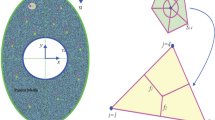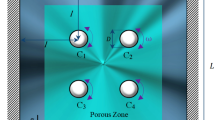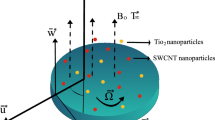Abstract
In current article, transportation of CuO nanoparticles through a porous enclosure is demonstrated. The enclosure has complex shaped hot wall. Porous media has been simulated via two temperature equations. Magnetic force impact on nanofluid treatment was considered. Control volume based finite element method has been described to solve current article in vorticity stream function form. Single phase model was chosen for nanofluid. Nanofluid characteristics are predicted via KKL model. Roles of solid-nanofluid interface heat transfer parameter (Nhs), porosity, Hartmann and Rayleigh numbers have been illustrated. Outputs illustrated that conduction mode reduces with augment of Ra. Increasing magnetic forces make nanofluid motion to decrease. Temperature gradient of nanofluid decreases with augment of Nhs. Reducing porosity leads to enhance in Nusselt number.
Similar content being viewed by others
Introduction
Solar power collectors and drying technologies are two common uses for porous enclosure. In some application, researchers should consider two- temperature model. Alsabery et al.1 demonstrated nanoparticletransportation in a tilted porous cavity. They indicated that convective flow is significantly influenced by the permeable layer augmentation. Lu et al.2 investigated about nanofluid radiative three dimensional flow containing gyrotactic microorganism with anisotropic slip. They considered the effect of activation energy. Zaimi et al.3 illustrated nanofluid boundary layer movement on a porous plate. Sheikholeslami and Shehzad4 showed the two temperature model for nanoparticle migration inside a permeable medium. They revealed that Nu increases with decrease of porosity. Khan et al.5 reported the nanofluid mixed convection over an oscillating vertical plate. They utilized Laplace transform method to solve the governing equations.
Sheikholeslami and Shehzad6 investigated the role of radiation on nanoparticle treatment. They found that Nu decreases with reduce of radiation parameter. Haq et al.7 used carbon nanotubes to improve convective heat transfer over plate with slip flow. Carbon Nanotubes has been dispersed in to engine oil by Haq et al.8 is examined of magnetic forces. Tripathi et al.9 illustrated viscous dissipation and Hall effects on nanofluid rotating flow. Selimefendigil and Oztop10 depicted impact of inclination on hydrothermal behavior. They found that titled angle can be used as control parameter.
Promvonge et al.11 applied new way in a duct to improve the thermal characteristics. Sheikholeslami12 described the impact of electric filed on nanofluid free convection. He proved that Nusselt number enhances by adding electric field. Aman et al.13 illustrated the nanofluid thermal improvement in migration of CNTs nanoparticles. Sheikholeslami and Seyednezhad14 illustrated nanofluid Electrohydrodynamic flow in a permeable enclosure. Different applications of Fe3O4-water nanofluid were categorized by Sheikholeslami and Rokni15. Akbar et al.16 showed the role of Hartmann flow on nanoparticles migration in a duct. Najib et al.17 demonstrated the impact of chemical factor on flow style. They found that the Nu augments with augment of curvature. Various articles were been available about nanoparticle migration through porous media18,19,20,21.
Current publication is about nanoparticle migration in a porous enclosure with two temperature model via CVFEM considering magnetic force. Results illustrate the roles of significant parameters on contours.
Explanation of Geometry
Figure 1 illustrates the details of current geometry. The hot wall can formulate by:
rout, rin, A, N are outer and inner radius, amplitude, number of undulation. The porous enclosure is full of nanofluid and influenced by magnetic force.
CVFEM and Explanation
Formulation
According to existence of magnetic force and two temperature model for porous medium the basic formulas are:
(ρCp)nf, (ρβ)nf, ρnf, σnf and knf, μnf can define as22:
where ϕ is nanofluid volume fraction. Required characteristics and parameters are illustrated in Tables 1 and 222.
Considering following definitions:
Final equations are:
where:
Boundary conditions are:
Nuloc and Nuave are:
CVFEM
The innovative in which triangular element is used and upwind method is applied for advection term is CVFEM (Fig. 1(b)). Gauss-Seidel is the name of the method which is used for final step as mentioned in ref.23.
Mesh Independent Test and Validation
Obviously, the final outputs should not alter by changing mesh size. So, this test should be done for various cases as illustrated Table 3. Also, we should be sure about accuracy of written code by applying this code for previous published problem. Table 4 and Fig. 2 illustrates nice accuracy24,25,26.
Comparison of the present solution with previous work (Kim et al.24) for different Rayleigh numbers when Ra = 105, Pr = 0.7; (b) comparison of the temperature on axial midline between the present results and numerical results obtained by Khanafer et al.25 for Gr = 104, ϕ = 0.1 and Pr = 6.2 (Cu−Water).
Results and Discussion
In current article, migration of nanoparticle in a porous medium which is described by new porous model is presented. Numerical method is applied to display the roles of the porosity (ε = 0.3 to 0.9), Rayleigh number (Ra = 100,500 and 103), Hartmann number (Ha = 0 to 20) and Nhs (Nhs = 10 to 1000).
Influences of Nhs, Ra, ε and Ha on isotherms for solid (θs), streamlines (Ψ) and nanofluid (θnf) were depicted in Figs 3, 4, 5, 6, 7 and 8. When buoyancy force is weak, conduction mode is significant and the impacts of other variables are negligible. In this case, (θnf) contours are similar to (θs) contours. As Ra increase, thermal plume can be seen close to the vertical centerline and (θnf) contours become more complex but (θs) contours have no changes. Velocity of nanofluid decrease with augment of magnetic forces and the (θnf) contours are stratified with enhance of Ha. (Ψmax) enhances with augment of Nhs due to stronger convective flow. As ε enhances, the pores volume through the enclosure augments. Therefore, convective flow becomes stronger. Besides, the impact of ε on isotherms is as same as Nhs.
Figures 9 and 10 depict the impact of Nhs, ε, Ha and Ra, on Nuave. Nuave can calculate as:
Coefficient of determination is 0.98 for this correlation. Also, in this formula we have: Ha* = 0.1Ha, Nhs* = 0.001Nhs, Ra* = 0.001Ra. Nuave is a reducing function of Nhs because temperature gradient decreases with augment of this factor. Decreasing porosity makes Nu to enhance which is similar of Ha impact. Nuave decreases with reduce of Rayleigh number.
Conclusions
In current research, migration of CuO nanoparticles is simulated via Non-equilibrium. Innovative method is applied to show the impacts of porosity, buoyancy, magnetic forces and the Nhs. Results show that Nuave reduces with augment of Ha, ε, Nhs. Convective flow enhances with increase of Nhs and ε while it reduces with enhance of magnetic force. When Ra = 1000, ε = 0.3, increasing Nhs leads to 17.06 percent decrement of Nuave in absence of magnetic field. Impact of Nhs is negligible in existence of Lorenz force. Also Nuave decreases about 53% with augment of Hartmann number.
References
Alsabery, A. I., Chamkha, A. J., Saleh, H. & Hashim, I. Natural convection flow of a nanofluid in an inclined square enclosure partially filled with a porous medium. Scientific Reports. 7, 2357 (2017).
Dianchen, L., Ramzan, M., Naeem, U., Chung, J. D. & Umer, F. A numerical treatment of radiative nanofluid 3D flow containing gyrotactic microorganism with anisotropic slip, binary chemical reaction and activation energy. Scientific Reports. 7, 17008 (2017).
Khairy, Z., Anuar, I. & Ioan, P. Boundary layer flow and heat transfer over a nonlinearly permeable stretching/shrinking sheet in a nanofluid. Scientific Reports. 4, 4404 (2014).
Sheikholeslami, M. & Shehzad, S. A. Simulation of water based nanofluid convective flow inside a porous enclosure via Non-equilibrium model. International Journal of Heat and Mass Transfer 120, 1200–1212 (2018).
Khan, I., Shah, N. A. & Dennis, L. C. A scientific report on heat transfer analysis in mixed convection flow of Maxwell fluid over an oscillating vertical plate. Scientific Reports. 7, 40147 (2017).
Sheikholeslami, M. & Shehzad, S. A. Thermal radiation of ferrofluid in existence of Lorentz forces considering variable viscosity. International Journal of Heat and Mass Transfer 109, 82–92 (2017).
Ul Haq, R., Nadeem, S., Khan, Z. H. & Noor, N. F. M. Convective heat transfer in MHD slip flow over a stretching surface in the presence of carbon nanotubes. Physica B: Condensed Matter 457(15), 40–47 (2015).
Ul Haq, R., Shahzad, F. & Al-Mdallal, Q. M. MHD Pulsatile Flow of Engine oil based Carbon Nanotubes between Two Concentric Cylinders. Results in Physics 7, 57–68 (2017).
Tripathi, R., Seth, G. S. & Mishra, M. K. Double diffusive flow of a hydromagnetic nanofluid in a rotating channel with Hall effect and viscous dissipation: Active and passive control of nanoparticles. Advanced Powder Technology 28, 2630–2641 (2017).
Fatih, S. & Hakan, F. Ö. Conjugate natural convection in a cavity with a conductive partition and filled with different nanofluids on different sides of the partition. Journal of Molecular Liquids 216, 67–77 (2016).
Promvonge, P. Thermal performance in square-duct heat exchanger with quadruple V-finned twisted tapes. Applied Thermal Engineering 91, 298–307 (2015).
Sheikholeslami, M. Numerical investigation of nanofluid free convection under the influence of electric field in a porous enclosure. Journal of Molecular Liquids 249, 1212–1221 (2018).
Sidra, A., Khan, I., Zulkhibri, I., Mohd, Z. S. & Qasem, M. M. Heat transfer enhancement in free convection flow of CNTs Maxwell nanofluids with four different types of molecular liquids. Scientific Reports 2445, 01358–3 (2017).
Sheikholeslami, M. & Mohadeseh, S. Simulation of nanofluid flow and natural convection in a porous media under the influence of electric field using CVFEM. International Journal of Heat and Mass Transfer 120, 772–781 (2018).
Sheikholeslami, M. & Rokni, H. B. Simulation of nanofluid heat transfer in presence of magnetic field: A review. International Journal of Heat and Mass Transfer 115, 1203–1233 (2017).
Noreen, S. A., Raza, M. & Ellahi, R. Interaction of nano particles for the peristaltic flow in an asymmetric channel with the induced magnetic field. The European Physical Journal- Plus 129, 155–167 (2014).
Najwa, N., Norfifah, B., Norihan, M. A. & Anuar, I. Stagnation point flow and mass transfer with chemical reaction past a stretching/shrinking cylinder. Scientific Reports 4178, 04178 (2014).
Sheikholeslami, M. CuO-water nanofluid flow due to magnetic field inside a porous media considering Brownian motion. Journal of Molecular Liquids 249, 921–929 (2018).
Syam, L. S. et al. Enhanced thermal conductivity and viscosity of nanodiamond-nickel nano composite nanofluids. Scientific Reports 4039, 04039 (2014).
Sheikholeslami, M. Numerical investigation for CuO-H2O nanofluid flow in a porous channel with magnetic field using mesoscopic method. Journal of Molecular Liquids 249, 739–746 (2018).
Yuan, M., Fenghua, S. & Yangzhi, C. Supercritical fluid synthesis and tribological applications of silver nanoparticle-decorated graphene in engine oil nanofluid. Scientific Reports 31246, 31246 (2016).
Sheikholeslami, M. Numerical simulation of magnetic nanofluid natural convection in porous media. Physics Letters A 381, 494–503 (2017).
Sheikholeslami, M. Application of Control Volume based Finite Element Method (CVFEM) for Nanofluid Flow and Heat Transfer, Elsevier, ISBN: 9780128141526 (2018).
Kim, B. S., Lee, D. S., Ha, M. Y. & Yoon, H. S. A numerical study of natural convection in a square enclosure with a circular cylinder at different vertical locations. International Journal of Heat and Mass Transfer 51, 1888–1906 (2008).
Khanafer, K., Vafai, K. & Lightstone, M. Buoyancy-driven heat transfer enhancement in a two-dimensional enclosure utilizing nanofluids. International Journal of Heat and Mass Transfer 46, 3639–3653 (2018).
Rudraiah, N., Barron, R. M., Venkatachalappa, M. & Subbaraya, C. K. Effect of a magnetic field on free convection in a rectangular enclosure. Int. J. Engrg. Sci. 33, 1075–1084 (1995).
Author information
Authors and Affiliations
Contributions
I.K. formulated the problem. M.S. computed the numerical results. I.K. and M.S. wrote the main manuscript text.
Corresponding author
Ethics declarations
Competing Interests
The authors declare no competing interests.
Additional information
Publisher's note: Springer Nature remains neutral with regard to jurisdictional claims in published maps and institutional affiliations.
Electronic supplementary material
Rights and permissions
Open Access This article is licensed under a Creative Commons Attribution 4.0 International License, which permits use, sharing, adaptation, distribution and reproduction in any medium or format, as long as you give appropriate credit to the original author(s) and the source, provide a link to the Creative Commons license, and indicate if changes were made. The images or other third party material in this article are included in the article’s Creative Commons license, unless indicated otherwise in a credit line to the material. If material is not included in the article’s Creative Commons license and your intended use is not permitted by statutory regulation or exceeds the permitted use, you will need to obtain permission directly from the copyright holder. To view a copy of this license, visit http://creativecommons.org/licenses/by/4.0/.
About this article
Cite this article
Sheikholeslami, M., Khan, I. & Tlili, I. Non-equilibrium Model for Nanofluid Free Convection Inside a Porous Cavity Considering Lorentz Forces. Sci Rep 8, 16881 (2018). https://doi.org/10.1038/s41598-018-33079-6
Received:
Accepted:
Published:
DOI: https://doi.org/10.1038/s41598-018-33079-6
Keywords
This article is cited by
-
Magnetic field promoted irreversible process of water based nanocomposites with heat and mass transfer flow
Scientific Reports (2021)
-
3-D magnetohydrodynamic AA7072-AA7075/methanol hybrid nanofluid flow above an uneven thickness surface with slip effect
Scientific Reports (2020)
-
Investigation of convective nanomaterial flow and exergy drop considering CVFEM within a porous tank
Journal of Thermal Analysis and Calorimetry (2020)
-
Uniform magnetic force impact on water based nanofluid thermal behavior in a porous enclosure with ellipse shaped obstacle
Scientific Reports (2019)













